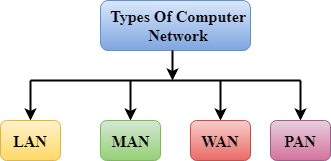NETWORK TYPES

Networks can be characterized both by their hardware as well as their size and scope. In the following sections, you will learn about the categories of networks based on their size and scope.
Local Area Network and Wireless LAN A local area network (LAN) is a group of computers and other devices usually located in a small area: a house, a small office, or a single building. The computers all connect via network cable to one or more switches and to a router for access to the Internet. A LAN can be as small as two devices or as large as several dozen devices.
A wireless LAN (WLAN) is a LAN in which the connections between devices are made with Wi-Fi.
Although the term hybrid LAN is not commonly used, it describes a mixture of wired and wireless technology. For example, the connections made between desktop computers can use network cable, but the connections made to laptop or mobile devices would use Wi-Fi.
Most LANs in small-office/home-office (SOHO) settings are effectively hybrid LANs. However, the term LAN is normally used for any type of local area network, regardless of how the devices are connected.
Metropolitan Area Network
A metropolitan area network (MAN) is a network of networks in the same locality that use direct high-speed connections to connect the networks. For example, a college campus has two satellite facilities a few blocks away from the main campus. The campus has a number
of LANs, and each satellite facility has a number of LANs. The connections on the main campus and in each facility can be made with copper, fiber, or wireless connections. The MAN can use fiber or WISP connections between locations.
Wide Area Network
A wide area network (WAN) is a group of two or more LANs or MANs over a large geographic area that are connected to each other seamlessly. For example, a financial institution’s home office, branch offices, and ATMs are in different cities, countries, or continents.
However, by being connected with a WAN, they appear to be on the same network. The financial institution would use fiber, networking, and wireless connections to build the WAN. Each LAN would require a router to connect to each other.
Personal Area Network
A personal area network (PAN) is a small, often temporary, computer network used to connect smartphones, tablets, and other small personal computing devices and accessories using Bluetooth.
A PAN is created when a user pairs a headset with a phone, a wireless keyboard with a desktop or laptop computer, and so on. The pairing process helps prevent unknown devices or computers from joining a PAN.
Storage Area Network
A storage area network (SAN) is a network separate from the normal LAN or MAN that is used strictly for storage. Unlike network-attached
storage (NAS), which locates drives or RAID arrays on the same network as PCs and mobile devices, SAN storage, because it’s on a separate network, can be accessed by any server connected to the SAN.
Because a SAN is on a network, if the most direct access to the storage devices on the SAN is affected by a network attack or slowdown, a different route to the SAN devices can be used to prevent downtime.
A SAN can use either of the following interfaces: Fibre Channel (which uses fiber optic and can provide speeds of up to 128Gbps at distances up to 10Km or 6 miles) or iSCSI, which can run over standard Ethernet networks. Fibre Channel is faster and more reliable than iSCSI,
but iSCSI is much cheaper and more flexible because it uses Ethernet. Both Fibre Channel and iSCSI use switches to connect to the network and to servers.


